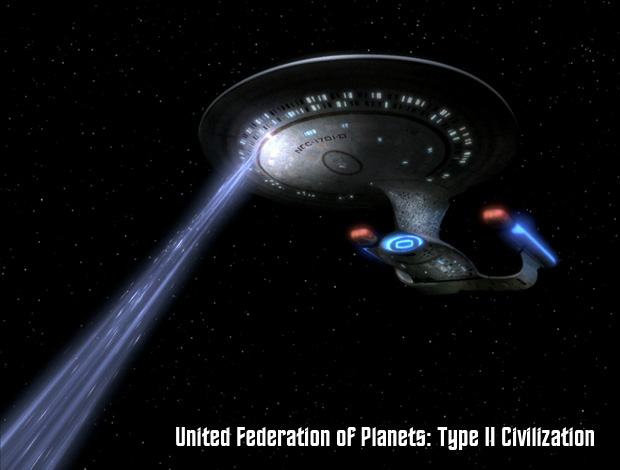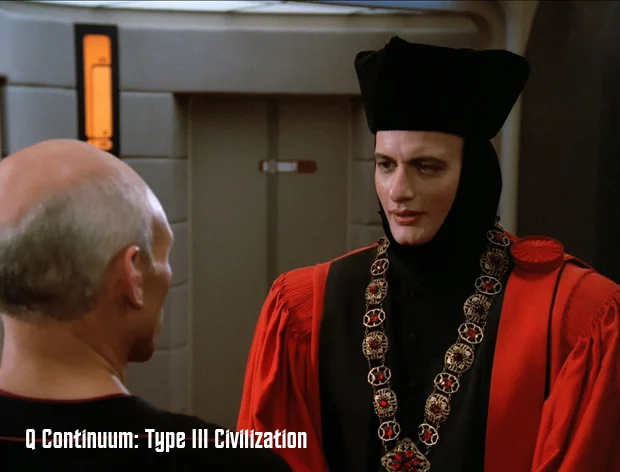An audio version of this Captain’s Log is available.
by Christopher Jones
We often hear scientists throwing around the fashionable statement that any alien civilization is going to be far advanced beyond our own. Such civilizations, they say, could be millions of years ahead of us. To them, we would be no more impressive than the ants are to us.
But what does it mean for a civilization to be a million years old? This is a question once posed by the late Carl Sagan. Is there any way to discuss this in understandable terms, or is it just an abstract concept meant only to inform us that we are primitive?
In Star Trek most of the civilizations we encounter are on roughly the same technological level as our own; or they are still at primitive stages of development similar to our Bronze Age. When we do see civilizations that a far advanced, they are typically extinct.
In this Captain’s Log we’ll examine an established method for classifying civilizations and find out where we are, where we’re headed, and just how far ahead of us those like the Iconians or that ancient humanoid played by Salome Jens may be.
A Scheming Scientist
Nikolai Kardashev was what some might call a schemer. After turning things over in his head and picking his moment, the Soviet astronomer proposed in 1964 a scheme for classifying civilizations that has become quite popular—even if only transparently—in SF and in speculation about our future in space.
This system, rather than focusing on cultural achievement or technological gadgetry, places civilizations in three groups based on their ability to harness and make use of energy. These groups are creatively named Type I, Type II, and Type III. Sounds good so far, but just what do these groupings mean? How can we get in the club?
Well, in a nutshell they can be broken down like this:
Type I: Controls the energy of an entire planet. This civilization can control the weather, can prevent earthquakes, and boasts mastery of an energy factor of about 10^16 watts. Though advanced, a Type I civilization still faces danger of extinction by natural disasters such as comet impacts.
Type II: Controls the energy of an entire star. It has the ability to directly mine the sun. This civilization will have explored completely its own star system and will have established a number of colonies in neighboring star systems. The energy factor mastered by a Type II civilization is about 10^26 watts, or a 10 billion-fold increase over that controlled by Type I. A Type II civilization is virtually immune to extinction.
Type III: Controls the energy of an entire galaxy. Such a civilization can manipulate space-time and possesses almost godlike powers. It would be threatened with extinction only by the death of the universe itself (and even this might be avoided). Energy mastery for a Type III civilization marks another 10 billion-fold increase, to a level of 10^36 watts.
So Where Are We?
We’re nowhere. OK, we’re on our way, but right now we are what would have to be called a Type 0 civilization. Our best computers cannot even predict the weather—much less control it. We have barely left the confines of our home planet, with human forays only to the moon and immediate Earth orbit. We spend incredible amounts of energy and resources bickering over inconsequential political boundaries, religious doctrines, and ideological differences. We only learned to tap the nuclear force within the past century. If we aspire to be even a Type I civilization, we have a long way to go.
But how long? Physicist Michio Kaku speculates in his book Hyperspace that we might reach Type I status—given our present rate of growth—within a few centuries. From there, the climb to Type II and Type III could be very rapid, with the transition from Type I to Type II occurring after only a thousand years. To go from Type II to Type III could take a few thousand years more.
The Express Lane
If it takes us some two billion years to go from tree-swingers to the first level of Kardashev’s civilization scheme, why could we make the jump to masters of the universe in only a few thousand? The answer to that is quite easy, though it may defy common sense.
The reason is that technological prowess and scientific knowledge increase exponentially. To put it another way, the more you know the more you can know. (Cue music and rainbow.) Currently, the total sum of human knowledge roughly doubles every 10 years. Put into these terms, it is easy to see what it could mean for a civilization to be a million years old.
The Star Trek and SF Connection
So how has the Kardashev system been utilized in SF? If we want to talk about Type I civilizations, then the answer would be that it has been utilized far and wide. Since a Type I civilization is one that controls the energy of its home planet, just about any basic spacefaring civilization you find in SF novels could fall into the category. Our own civilization is frequently portrayed as Type I (in stories set in the relatively near future). To jump into specific examples, let’s move on to the far more interesting Types II and III.
The best-known example of a Type II civilization is the United Federation of Planets. The Klingons, Romulans, Borg, and others would also fall into Type II. The UFP’s technology is sufficiently advanced that it can directly utilize the energy of a star, can propel ships at many times the speed of light, and can even accomplish semi-controlled time travel—an early indication of progress towards Type III status.
One thing that is very interesting about this is that Star Trek (in its TNG-era incarnations) is set only 300 years or so from the present day. Clearly we are not on track to achieve Type II status within that time frame. Nevertheless, Star Trek remains popular in part because the future it portrays appears to be a plausible, natural progression of our current state of affairs.
Moving on to Type III, a very good example—and one that Kaku gives in Hyperspace—is the civilization portrayed in Isaac Asimov’s Foundation series. This is a civilization that has not only had the time to expand throughout the galaxy, but has flourished for millennia and is facing collapse. The central plot of the original trilogy is the attempt to rebuild the empire in only a thousand years following the collapse, stemming off ten thousand years of potential barbarism.
Back in the Star Trek arena, the Q Continuum could fall into the Type III category. I say “could” because we’ve never really been shown enough of them to judge the true nature of their civilization (which I think is part of the point: they are too far evolved for our comprehension, the message says). But from what I’ve seen, they’re definitely not Type II. They’re Type III or perhaps even Type IV—meaning they are extra-dimensional, which would explain how Q pulls off a lot of his tricks.
So Kardashev civilizations can actually be found in almost any SF story you read—even if it is only Type 0, our present status. Next time you dive into a novel, short story, or an episode of Star Trek see if you can judge where the tale’s civilization falls on the scale.
The Road Less Traveled
If we aspire to be the civilization we see in Star Trek, what do we have to do to get there? Aren’t we sufficiently advanced at this point that we have an open road ahead?
Well, as far as science and technology go, I’d say all we need to do to get there is to continue progressing as we are. We must continue to ask questions and continue to push the limits of our understanding of the universe. Certainly our minds can take us where we need to go.
But our minds can also take us where we don’t need to go. Our species is consumed in hatred and fear. We don’t like the person across the street because their skin is a different color. We don’t like the neighboring country because they believe that health care should be controlled by the government rather than by private companies. We don’t like a given group of people because they communicate by connecting sounds in a different way than we do. These inborn fears divide our planet into countless nation states. Even these nation states are divided within. We waste resources on war, kill millions, and ignore our real needs. What’s wrong with us?
As it turns out there may be nothing wrong with us; or at least nothing unusual. When we peer out at the stars—or listen with our radio telescopes, to be more accurate—we find no one. There are no radio signals coming from Type I, II, or III civilizations. If a civilization is a million years old, surely we should notice its presence. Why is no one calling?
The fact of the matter is that Type 0 civilizations like ours might be quite common in the universe, but they destroy themselves before reaching Type I status because of the very fear and hatred I just mentioned. As technological development accelerates, every civilization is going to discover element 92: uranium. With this discovery comes a fork in the road. To the left is prosperity, to the right is destruction.
Chances are most civilizations veer to the right. To choose the left requires a willingness to let go of national boundaries and idealistic dogma. As Kaku said, a Type I civilization by it’s very nature must be a global civilization. There is no room for our fear and hatred on the journey up the Kardashev ladder. So what will we make of our future? Will we take the easy way out, or will we choose the road less traveled. Our decision will make all the difference.






